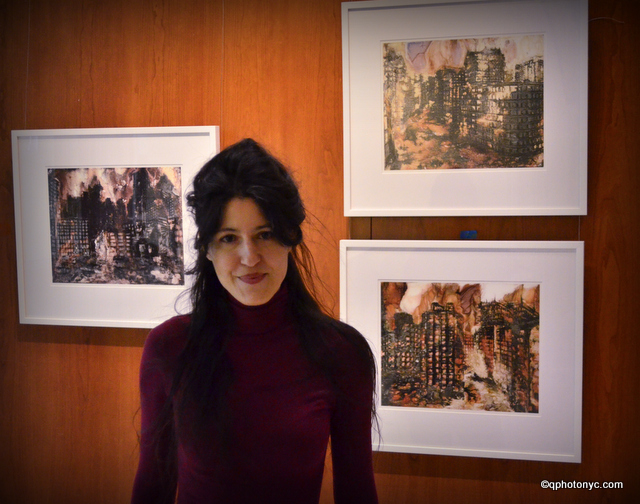February 21, 2017
Russ Berrie Medical Science Pavilion
1150 St. Nicholas Ave., NY, NY 10032
Eva Nikolova: 21 Fragments of Yesterday and Tomorrow (2015-2016)
The relationship between geography and memory has been the central preoccupation in my work ever since moving to the US from my native Bulgaria in 1992. When past and present are geographically discontinuous, as they are for the immigrant, remembrance is forever bound up with place, with what must be the meaning of home. And so it is that through my drawing, printmaking, animation and cameraless photography, I am drawn to images of land and dwellings, and to narratives of displacement, loss, longing and remembrance.
In 21 Fragments of Yesterday and Tomorrow, I set out to create a suite of works as a meditation on the radical metamorphosis of the place I grew up in, then left, then revisited after a decade’s absence. What I found was the landscape of my youth being transformed into a sort of construction site without prior history, where construction and destruction were effectively indistinguishable. And yet it became apparent to me that even when all traces of a past are erased, landscape is haunted by memory no less than memory by landscape.
To arrest this erasure, I might have reached for my camera, that device seen as the conserver of memory. But for me – this will seem paradoxical to some – nothing can erase the experience of the past quite like a photograph, which replaces what it purports to preserve. To create photographs that would not rob me of the subjectivity of lived experience, I would have to go back to the dawn of the medium before the tyrannical ubiquity of the camera, when it was still an outgrowth of a free experimentalism with materials, of unfettered curiosity, and of a fascination with the making of marks on paper.
I began the works in 21 Fragments with drawings from memory, which then went through various transformations spanning media and technologies both historic and contemporary. As a printmaker by training and mindset, who processes experience through drawing and who has dedicated the last few years to cameraless photography, I turned to the cliché-verre, an obscure cameraless, inkless printmaking technique in which a hand-designed matrix (as in printmaking) is traced by means of light onto light-sensitive paper (as in photography).
Even after it enjoyed a brief rediscovery by the avant-garde in the century just past, cliché-verre has remained a practice decidedly on the fringes of both photography and printmaking and as a graphic medium has been seldom used since the mid 19th century. My own introduction to it came about in 2011 at Manhattan Graphics Center in NYC thanks to American printmaker and cameraless photographer Douglas Collins, who also later introduced me to bleach-etching – that rare and mysterious process which I use in conjunction with cliché-verre, to create in the space between illusion and materiality, object and image.
While the original cliché-verre matrix was a glass plate onto which a drawing was made with an etching needle through a smoked etching ground or printmaking ink that had been dusted white, contemporary approaches use a wide range of drawing substances and tools. To make the matrix, I drew with graphite, charcoal, black and white ink, white chalk and oil pastel. Because I mixed a variety of materials, whose visible tones do not coincide with their opacity – which is what matters when making a negative to print from – I photocopied the drawing onto thin printer paper often re-working this copy by scratching through the toner with a blade. This then was the matrix contact-printed under the enlarger onto gelatin silver photographic paper developed with standard darkroom chemistry to yield cliché-verre prints, that would constitute a sizeable edition, were the process to end here. But rather than the end point, each cliché-verre was merely the stage for a series of further interventions, transforming each print into a unique image that if successful was to serve as a matrix once more, when it would be scanned and output as an archival pigment print.
In a precarious process, where creation takes place on the edge of destruction, the clichés-verre were bleach-etched until the image disappeared and the emulsion with its metallic silver began to lift off. The fragile emulsion was in places rubbed away, and in others painstakingly rearranged with a needle, while the prints were selectively redeveloped in a process that, owing more to painting and alchemy than to photography, resurrected chosen parts of the vanished picture, imparting color to the black and white prints solely through chemical interactions. The gelatin-silver emulsion, equally a site of creation and dissolution, became the embodiment of the themes of the work – the nature of transformation and the interchangeability of construction and destruction within the unstable and fragmentary edifice of memory itself.
Through the singularity of the process that gave rise to them, these 21 prints endeavor to restore the overused image of my native landscape to personal significance: the archetypal Balkan landscape ‐ alternately constructed as site of genocidal brutality, exotic getaway, or iconic object of nationalistic pride ‐ instead became the locus of a deeply personal connection to a place and its past. While reminding of the region’s history of war and its current predicament of speculative development and ecological ruination, the works transcend the specificity of the context they arise from: ruins evoke not only their own site, but resonate with other images of decay, catastrophe and destruction, functioning as a trope of global trauma and the ever‐increasing wreckage of modernity.

